Surprise! Even Conservative Investors Could Profit on Bitcoin
Risk is misunderstood. Here’s one way to use a volatile asset – and Bitcoin is about as volatile as investments get – to help your portfolio.


Money managers have two top priorities: identifying and investing in non-correlated assets, and rebalancing around volatility. With the ups and downs of the past year, it’s a perfect time to discuss the value of volatility and how a sound rebalancing process can harvest it to add value.
Let’s start with a hypothetical: If an asset has a return of zero percent over the long term, can it add significant value to an investor? The answer lies in its volatility.
Here is a graph of the hypothetical asset. It returns zero percent over the long term, but it experiences large swings, going down 50%, returning to even, going up 50%, and then back down to even. Over and over again.

Sign up for Kiplinger’s Free E-Newsletters
Profit and prosper with the best of expert advice on investing, taxes, retirement, personal finance and more - straight to your e-mail.
Profit and prosper with the best of expert advice - straight to your e-mail.
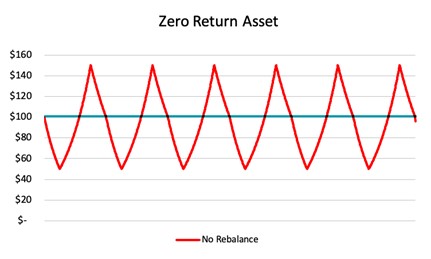
Say someone makes an initial investment of $100 in this asset, and their money manager/adviser places a rebalancing strategy around the holding. If the value of the holding drops 20%, buy it back up to $100, or buying low-ish. If the value rises 25%, sell it back to $100, or selling high-ish.
Over time, the portfolio would then look like this:
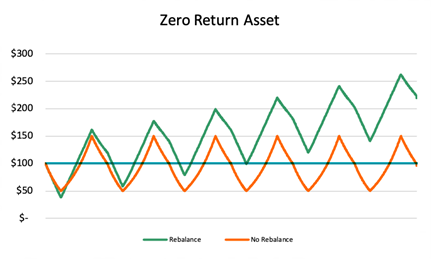
The buy-and-hold portfolio generates a total return of zero percent. The rebalanced portfolio generates a total return of 119%, or an average annual return of 14%.
Note: If, perhaps, you have a crystal ball and know that an asset will only go down, don’t buy it! If your crystal ball indicates that an asset will only go up, never sell it. But if you don’t have a crystal ball — and since historically assets experience both ups and downs — a rebalancing strategy is actually what matters.
Volatility, if used correctly, is an investor’s friend.
Bitcoin has been among the most volatile assets of all time. But the more volatile an asset, the less of it you want in a portfolio. Currently, there is only one way to purchase Bitcoin in a brokerage account, which is through the Grayscale Bitcoin Trust, ticker GBTC.
Let’s run a fictitious study… assuming you purchased GBTC at its all-time high, on Dec. 18 of 2017. This would have been the worst possible day to make the purchase. The price was $38.05 per share (the current price is around $20). Here is what would have happened to your $100 investment.
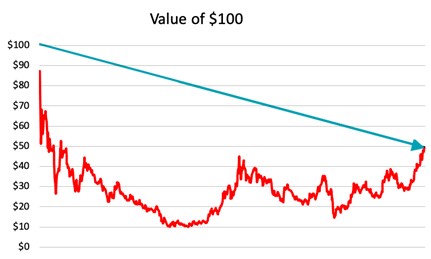
The buy-and-hold investor would have lost around half of their money. Now, let’s put a rebalancing strategy around this. If it goes down 33%, buy some. If it goes up 50%, sell some. Remember there is nothing magic about the rebalance parameters presented here … almost any reasonable parameters provide value. The parameters used here are not intended to maximize results, but are roughly based on volatility.
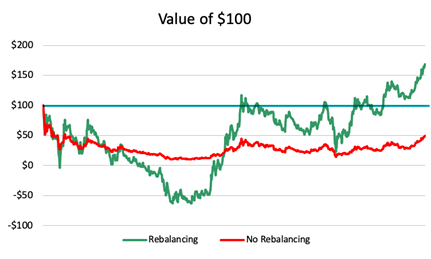
The rebalancing strategy took an asset that lost half of its value and turned it into a positive 70% return.
An investor does not need a positive view on Bitcoin, only an understanding of its volatility. No one knows what the future holds. In the medium-term, the volatility of Bitcoin is likely to add value to portfolios merely through a sound rebalancing process.
How much of a volatile asset should you own?
If you believe that an asset will behave in a different manner than the rest of your portfolio, the question isn’t whether you should own it. The question is how much of it you should own? Bitcoin will, of course, behave differently than the average portfolio, but by harvesting volatility, you can add value over time.
One should not go crazy here. Remember: The more volatile an asset, the less of it you should own. A 2% position won’t make or break you. Again, there’s no crystal ball. But rebalancing is key to navigating how valuable it can be.
Get Kiplinger Today newsletter — free
Profit and prosper with the best of Kiplinger's advice on investing, taxes, retirement, personal finance and much more. Delivered daily. Enter your email in the box and click Sign Me Up.

Randy Kurtz, RIA, CFP®, is a nationally recognized expert on risk. Challenging the financial industry's status quo for over a decade, Kurtz feels the standard Wall Street portfolio comes with far more risk than clients realize. He created a method of investing that aims to lower excess risk taken in client portfolios, without reducing expected return. His goal is to transform the industry by turning the client-adviser relationship from a return-centered conversation to a risk-centered one.
-
 How to Access Private Markets with Interval Funds
How to Access Private Markets with Interval FundsLet's explore how interval funds work — and how they're opening the doors to private market investing.
By Nicholas Pope
-
 Bouncing Back: New Tunes for Millennials Trying to Make It
Bouncing Back: New Tunes for Millennials Trying to Make ItAdele's mournful melodies kick off this generation's financial playlist, but with the right plan, Millennials can finish strong.
By Alvina Lo
-
 Bouncing Back: New Tunes for Millennials Trying to Make It
Bouncing Back: New Tunes for Millennials Trying to Make ItAdele's mournful melodies kick off this generation's financial playlist, but with the right plan, Millennials can finish strong.
By Alvina Lo
-
 Early-Stage Startup Deals: How Do Convertible Notes Work?
Early-Stage Startup Deals: How Do Convertible Notes Work?Some angel investors support early startups by providing a loan in exchange for a convertible note, which includes annual interest and a maturity date.
By Murat Abdrakhmanov
-
 SRI Redefined: Going Beyond Socially Responsible Investing
SRI Redefined: Going Beyond Socially Responsible InvestingNow that climate change has progressed to a changed climate, sustainable investing needs to evolve to address new demands of resilience and innovation.
By Peter Krull, CSRIC®
-
 Here's When a Lack of Credit Card Debt Can Cause You Problems
Here's When a Lack of Credit Card Debt Can Cause You ProblemsUsually, getting a new credit card can be difficult if you have too much card debt, but this bank customer ran into an issue because he had no debt at all.
By H. Dennis Beaver, Esq.
-
 Going to College? How to Navigate the Financial Planning
Going to College? How to Navigate the Financial PlanningCollege decisions this year seem even more complex than usual, including determining whether a school is a 'financial fit.' Here's how to find your way.
By Chris Ebeling
-
 Financial Steps After a Loved One's Alzheimer's Diagnosis
Financial Steps After a Loved One's Alzheimer's DiagnosisIt's important to move fast on legal safeguards, estate planning and more while your loved one still has the capacity to make decisions.
By Thomas C. West, CLU®, ChFC®, AIF®
-
 How Soon Can You Walk Away After Selling Your Business?
How Soon Can You Walk Away After Selling Your Business?You may earn more money from the sale of your business if you stay to help with the transition to new management. The question is, do you need to?
By Evan T. Beach, CFP®, AWMA®
-
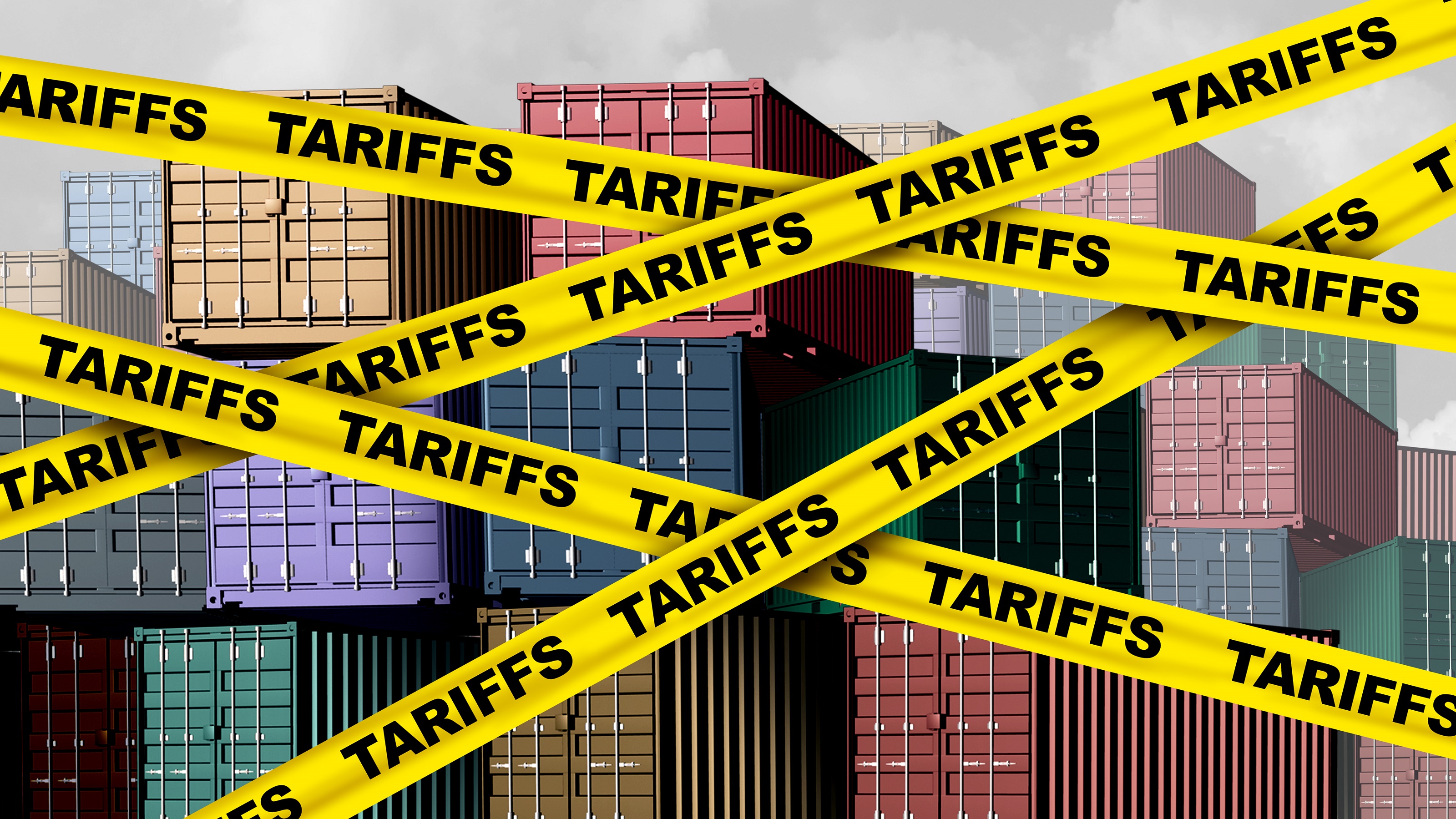 Two Don'ts and Four Dos During Trump's Trade War
Two Don'ts and Four Dos During Trump's Trade WarThe financial rules have changed now that tariffs have disrupted the markets and created economic uncertainty. What can you do? (And what shouldn't you do?)
By Maggie Kulyk, CRPC®, CSRIC™